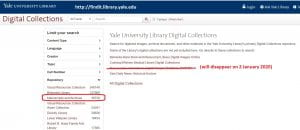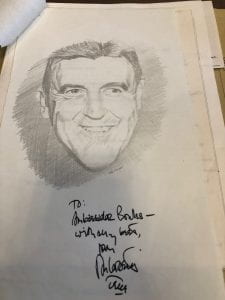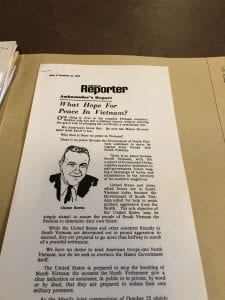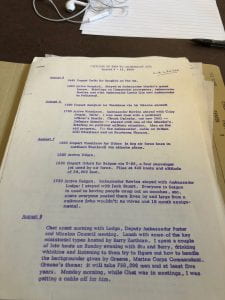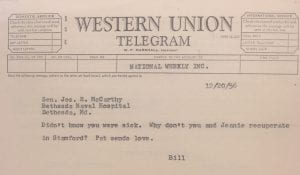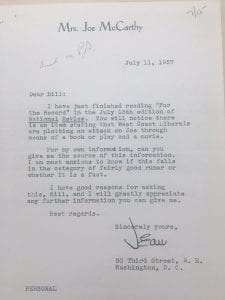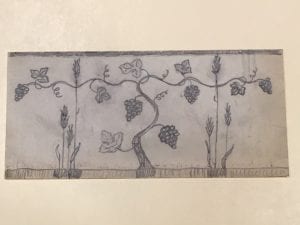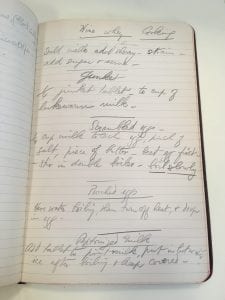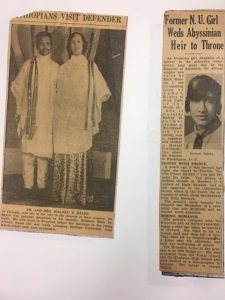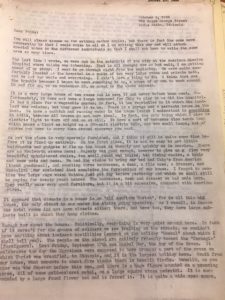The following information on recently acquired and processed collections was assembled by Alison Clemens, assistant head of arrangement and description. Manuscripts and Archives has recently acquired and made available the following collections and additions to existing collections:
New collections
Catalunya Independence Movement Ephemera (MS 2099)
The collection (totaling 5.75 linear feet) contains ephemera related to the 2017 Catalan Independence Referendum, Declaration of Independence, and related elections. Ephemera includes cloth banners and bags, newspapers, pamphlets, stickers, and posters.
New Blue, Yale University, Records (RU 1160)
The records (totaling 10 linear feet) consist of tour records, performance events, scrapbooks, photographs and musical recordings from New Blue, the first women’s a cappella group at Yale University. Access to the records requires permission from the archivist of New Blue.
Additions to existing collections
Accession 2016-M-0089 of the Harold C. Conklin Papers (MS 1956)
This accession (totaling 50.75 linear feet) comprises Yale University administrative and teaching files, topical files, professional service files, and correspondence documenting Harold Conklin’s professional responsibilities at Yale University and in professional organizations. The Yale University files document Harold Conklin’s tenure at Yale University, including trips with the Association of Yale Alumni, teaching and research records from the Anthropology and Linguistics departments, and curatorial files from the Peabody Museum of Natural History. The records also document Conklin’s professorial and administrative responsibilities at Yale, particularly in the Department of Anthropology, such as his chair and committee service, courses and exhibitions, the Agrarian Studies Program, Southeast Asia Studies activities, and the development of Human Relations Area Files. The bulk of the collection is open for research. Access to Yale University administrative files is prohibited for 35 years from creation of the records. Access to student and personnel files is prohibited for 75 years or life plus five years (whichever is longer).
Accession 2018-M-0030 of the Hadley Family Papers (MS 985)
This accession (totaling 3.58 linear feet) consists of correspondence between members of the Hadley and Morris families and includes letters by and to Helen Hadley, Arthur Twining Hadley, and their children. Also includes studio portraits of family members and memorabilia, including documentation of academic achievements and family finances.
Accession 2018-M-0058 of the Louis H. Pollak Papers (MS 1989)
This accession includes a notebook of mementos prepared for the twentieth anniversary of Judge Louis H. Pollak’s appointment to the federal bench as judge for the United States District Court for the Eastern District of Pennsylvania. Also includes other documentation related to his anniversary celebration.
Accession 2018-A-0082 of the Yale University Press Records (RU 554)
This accession comprises acquisition files for the Yale University Press, 1982-2016. Access to the materials is restricted until January 1, 2052.
Accessions 2019-M-0004 and 2019-M-0024 additions to the Duncan Chaplin Lee and John Lee Papers (MS 2062)
Accession 2019-M-0004 contains the personal papers of Duncan Chaplin Lee and includes personal and family photographs and albums; correspondence between Duncan Chaplin Lee, family, friends, and colleagues; and clippings. Accession 2019-M-0024 consists of the personal papers of Duncan Chaplin Lee, including correspondence with his son John Lightfoot Lee and other family members, and biographical material of the Lee family, including written accounts by Duncan Chaplin Lee. Accession 2019-M-0024 also contains a photograph album documenting Duncan Chaplin Lee’s time in Burma during World War II.
Accession 2019-A-0017 of the Ravi D. Goel Collection on Yale (RU 1081)
This accession (totaling .5 linear feet) consists of letters and legal documents, 1726-1799, documenting Yale affiliated individuals and organizations, collected by Ravi D. Goel.
Accession 2019-M-0020 of the G. Evelyn Hutchinson Papers (MS 649)
This accession (totaling .25 linear feet) comprises correspondence to and from G. Evelyn Hutchinson, including letters written by Hutchinson to Yemaiel Oved Aris, who resided with the Hutchinsons in New Haven during World War II. It also includes letters between Hutchinson’s colleagues regarding Hutchinson, class lecture notes taken in Fall 1953 by Estella B. Leopold (born 1927; Yale PhD 1955) for Hutchinson’s Ecological Principles class, and photographs of Hutchinson family members.
Accession 2019-M-0025 of the Henry Lewis Stimson Papers (MS 465)
This accession is a guest book for Highhold, Henry L. Stimson’s house in West Hills, Huntington, New York, 1905-1937.
Accession 2019-A-0025 of the Employee Unions and Strikes, Yale University, Records (RU 105)
This accession (totaling .25 linear feet) contains correspondence, promotional material, and ephemera documenting faculty and graduate student support of the 1984 Yale University clerical and technical employees strike.
Accession 2019-M-0033 addition to the John Glines Papers (MS 1895)
This accession (totaling 1.92 linear feet) consists of the writings of playwright John Glines, including scripts of productions performed at The Glines Theatre in New York City, personal and autobiographical writings, and a daily journal. The papers also include correspondence and recordings of author Erlo Van Waveren and production materials from Glines’s play Butterflies and Tigers, including video and audio recordings.
Accession 2019-A-0031 of the Yale University Buildings and Grounds Photographs (RU 703)
This accession contains a photogravure of a circa 1906 bird’s-eye view of Yale University, drawn and signed by Richard Rummell (1848-1924) and published by F. D. Nichols of Boston.
Accession 2019-A-0032 of the Yale Diploma Collection (RU 150)
This accession contains the 1856 BA, 1859 MA, and 1863 PhD diplomas of Lewis Richard Packard, classics scholar and Yale professor of Greek.
Accessions 2019-A-0034, 2019-A-0035, and 2019-A-0050 additions to the Yale Course Lectures Collection (RU 159)
These small additions to the Yale Course Lectures Collection include art history course materials and notebooks of Susan P. Casteras (1973 MA, 1975 MPhil, and 1977 PhD); course notes, examinations, and papers of Mark Hubert Curtis (1942 Yale College, 1953 PhD); and a 1966-1967 Math 131 lecture notebook titled “Natural Function Algebras” of professor Charles E. Rickart.
Accession 2019-A-0048 of the Whim ‘n Rhythm, Yale University, Records (RU 210)
This accession consists of a diary written by Charlotte Juergens during the 2016 Whim ‘n Rhythm world tour.
Accession 2019-A-0054 of the Yale Events and Activities Photographs (RU 690)
This accession comprises a New York Graphic article depicting four Yale secret society buildings: Skull and Bones, Scroll and Key, Delta Kappa Epsilon, and Phi Upsilon, 1886 June 19.
Accession 2019-A-0055 of the Yale College records of Classes (RU 491)
This accession contains a photograph album for the Yale College class of 1865.
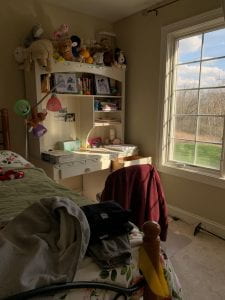 “Desk in my brother’s room at home. Around me were childhood stuffed animals, a turtle tank and a full-size bed. Important to me is the sunlight filtering in. Lighting has had a drastic influence on my mood, motivation and study habits. The same is what occurs in my brain, the logical connections, the development of claims, the cranking out of problems. But nothing outside my mind has continued the same. I miss the intellectual generosity that the Yale space fosters and that my peers bring into my life.”
“Desk in my brother’s room at home. Around me were childhood stuffed animals, a turtle tank and a full-size bed. Important to me is the sunlight filtering in. Lighting has had a drastic influence on my mood, motivation and study habits. The same is what occurs in my brain, the logical connections, the development of claims, the cranking out of problems. But nothing outside my mind has continued the same. I miss the intellectual generosity that the Yale space fosters and that my peers bring into my life.”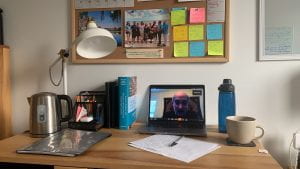 “I lived in Baker Hall, my work-space was the desk next to my bed. I had a nice view of the trees from my window. In had everything I needed in my small work-space: a small pot to warm water for tea, my computer for attending my online classes, a lamp, a calendar, and pictures to remind me of my family and home (Mexico). I played the ukulele to relax, each post-it was a new ukulele song. I had three boards on the walls to write down my ideas, a section of my one of my boards can be seen in the reflection on the mirror.”
“I lived in Baker Hall, my work-space was the desk next to my bed. I had a nice view of the trees from my window. In had everything I needed in my small work-space: a small pot to warm water for tea, my computer for attending my online classes, a lamp, a calendar, and pictures to remind me of my family and home (Mexico). I played the ukulele to relax, each post-it was a new ukulele song. I had three boards on the walls to write down my ideas, a section of my one of my boards can be seen in the reflection on the mirror.” “My family and I moved from CT to NJ during our spring break. Due to the quarantine, we weren’t able to buy a lot of the furniture we were planning to and I built myself a makeshift desk out of boxes and totes. The desk is in my room and was definitely a huge improvement from sitting on my bed for hours on end.”
“My family and I moved from CT to NJ during our spring break. Due to the quarantine, we weren’t able to buy a lot of the furniture we were planning to and I built myself a makeshift desk out of boxes and totes. The desk is in my room and was definitely a huge improvement from sitting on my bed for hours on end.”
